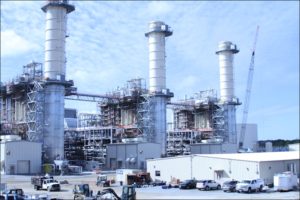
By Peter Galuszka
International financial analysis firm S&P Global has issued a scathing report criticizing Dominion Energy Virginia for over emphasizing future electricity demand and proposing unneeded natural gas-fired generating plants.
According to S&P: “An examination of State Corporation Commission, or SCC, records; Dominion’s past integrated resource plans, or IRPs; campaign finance documents; and independent reports, along with interviews with utility analysts and environmental advocates and statements from Dominion officials, shows that the company has consistently over-forecast electricity demand to justify building new capacity, primarily natural gas plants with dubious economics that will ultimately be paid for by ratepayers.”
Dominion plans on adding at least eight gas plants with a generating capacity of 3,700 megawatts by 2033, S&P reports. An update to its 2018 IRP plan would add three alternatives that would add 2,425 megawatts of gas capacity by 2044.
The new capacity is in addition to the relatively new Brunswick and Greensville Power gas plants that can put out 3,000 megawatts of power and cost more than $2 billion to build, says S&P.
S&P states: “The proposals come as electricity demand in Virginia grew less than 1% from the Great Recession of 2007-2008 through 2017, according to the U.S. Energy Information Administration, and is projected to remain essentially flat for at least the next decade. In an era of little to no demand growth, when it is already removing plants from service long before their planned retirement dates, Dominion continues to add thousands of megawatts of new gas-fired capacity. And since it is a regulated monopoly, the company continues to pass the costs of those plants along to its customers.”
Dominion says that the new gas capacity is needed to act as a “bridge” to cover generation needs as it moves forward with ambitious plans to build more renewable power sources such as wind and solar. Plus, other capacity is needed when renewables can’t work at night or when the wind isn’t blowing.
It also has said that Virginia has attracted a number of jobs-creating data centers that have increased demand for power, but S&P notes that such companies typically insist that they be powered from renewable sources.
The S&P report, issued Dec. 4, is part of a week-long series of analytical stories exploring similar dilemmas in other states as utilities push ahead with natural gas plants that S&P says are not needed.
Curiously, S&P does not mention Dominion’s mother company’s involvement in a partnership to build a $7 billion pipeline from Marcellus shale natural gas fields in West Virginia through Virginia and on into North Carolina. The 600- plus mile-long project has been highly controversial with environmentalists and property owners who have sued over eminent domain issues regarding rights of way. The project has been tied up in a fight over permits for about a year.
S&P also does not note that a Dominion company owns a liquidized natural gas on the Chesapeake Bay in Lusby, Md. that exports gas.
It is important to note that the critical report was issued by a firm that handles financial analysis for investors and thus might tend to be unbiased. A number of environmental groups, however, have praised the S&P report.
(Full disclosure: I worked for the McGraw-Hill Companies which used to own S&P for 18 years and my pension funds are overseen by S&P Global but I never worked for S&P)

Leave a Reply
You must be logged in to post a comment.